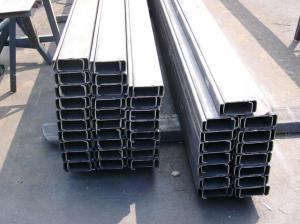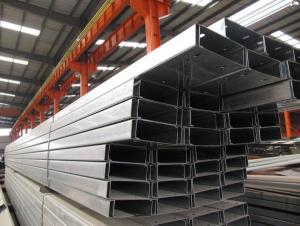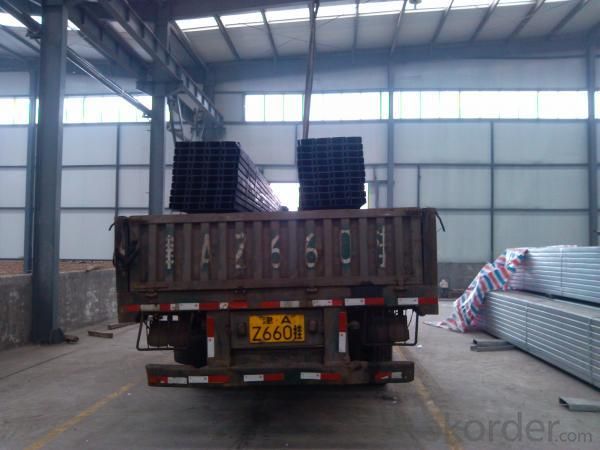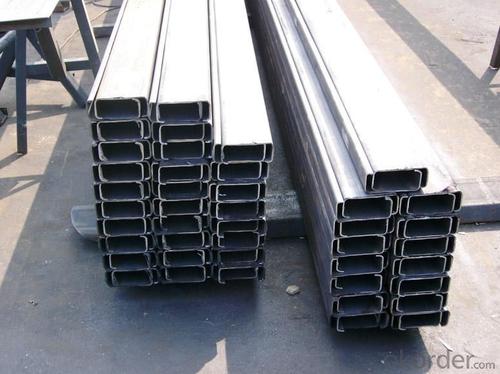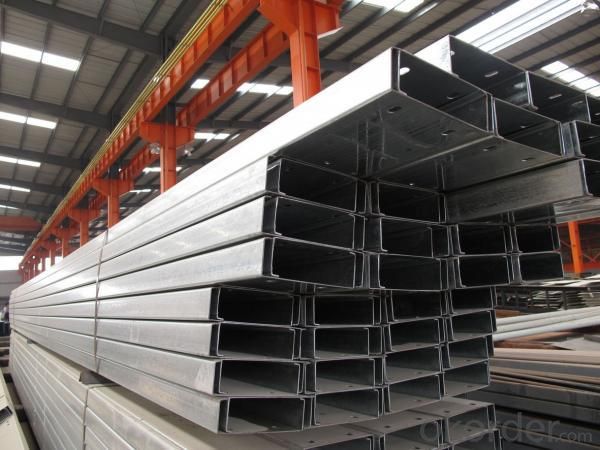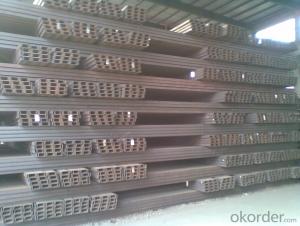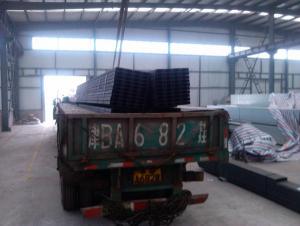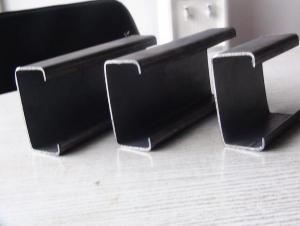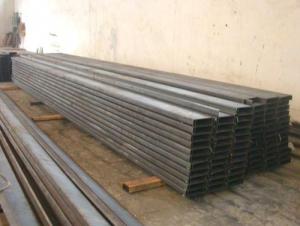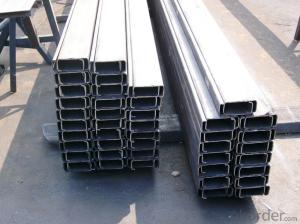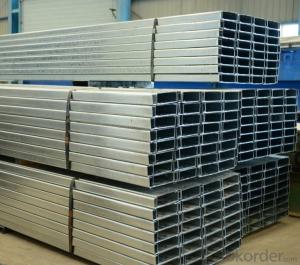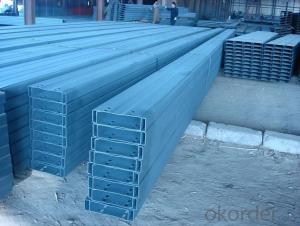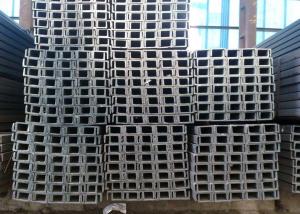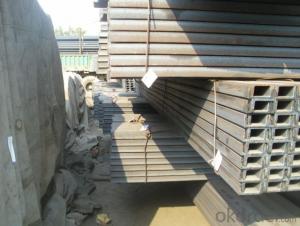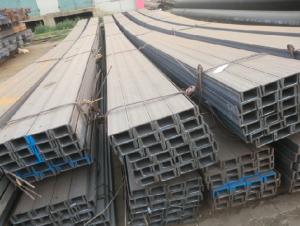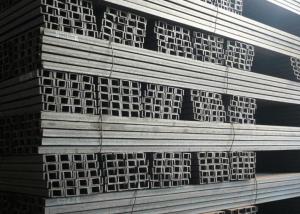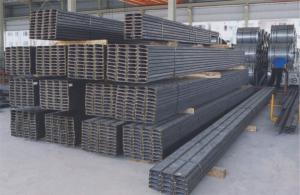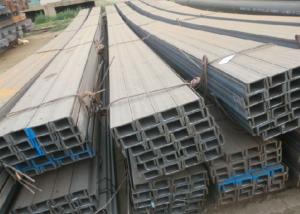Cold-Rolled C Channel Bar
- Loading Port:
- Tianjin Port,China
- Payment Terms:
- TT or LC
- Min Order Qty:
- 50MT m.t.
- Supply Capability:
- 1000 tons per month m.t./month
OKorder Service Pledge
OKorder Financial Service
You Might Also Like
Specifications of Cold-Rolled C Channel Bar:
1.We supply high quality Cold-Rolled C Channel Bar at reasonable price, including Chinese standard, Japanese standard and so on.
Standard | GB/JIS/EN/ASTM/DIN |
Material Grade | Q235B,Q235,Q345,Q345B,SS400,S235JRG1,A36,ST37-2 |
Technique: | Cold Rolled |
Sizes as per chinese standard: |
80×40×20×2.5 - 180×60×20×2.5
|
Sizes as per Japanese standard: |
180×60×20×3 – 300×80×20×3 |
Length: | 6meter, 9meter, 12meter |
Note: we are also competent to provide our customers other Cold-Rolled C Channel Bar based on other sizes according to customer’s requirements.
2. The detailed sections of Cold-Rolled C Channel Bar as per GB standard.Just as followings in the table-1:
Size | Weight(kg/m) | Size | Weight(kg/m) |
80×40×20×2.5 | 3.925 | 180×60×20×3 | 8.007 |
80×40×20×3 | 4.71 | 180×70×20×2.5 | 7.065 |
100×50×20×2.5 | 4.71 | 180×70×20×3 | 8.478 |
100×50×20×3 | 5.652 | 200×50×20×2.5 | 6.673 |
120×50×20×2.5 | 5.103 | 200×50×20×3 | 8.007 |
120×50×20×3 | 6.123 | 200×60×20×2.5 | 7.065 |
120×60×20×2.5 | 5.495 | 200×60×20×3 | 8.478 |
120×60×20×3 | 6.594 | 200×70×20×2.5 | 7.458 |
120×70×20×2.5 | 5.888 | 200×70×20×3 | 8.949 |
120×70×20×3 | 7.065 | 220×60×20×2.5 | 7.4567 |
140×50×20×2.5 | 5.495 | 220×60×20×3 | 8.949 |
140×50×20×3 | 6.594 | 220×70×20×2.5 | 7.85 |
160×50×20×2.5 | 5.888 | 220×70×20×3 | 9.42 |
160×50×20×3 | 7.065 | 250×75×20×2.5 | 8.634 |
160×60×20×2.5 | 6.28 | 250×75×20×3 | 10.362 |
160×60×20×3 | 7.536 | 280×80×20×2.5 | 9.42 |
160×70×20×2.5 | 6.673 | 280×80×20×3 | 11.304 |
160×70×20×3 | 8.007 | 300×80×20×2.5 | 9.813 |
180×50×20×2.5 | 6.28 | 300×80×20×3 | 11.775 |
180×50×20×3 | 7.536 | ||
180×60×20×2.5 | 6.673 |
Table-1
3. The chemical composition of Cold-Rolled C Channel Bar according to Q235B is shown in Table-2.
Alloy No | Grade | Element(%) | ||||
C | Mn | S | P | Si | ||
Q235 | B | 0.12-0.20 | 0.3-0.7 | ≦0.045 | ≦0.045 | ≦0.3 |
Table-2
Note: we are able to present our customers relevant SGS test report for chemical composition of Cold-Rolled C Channel Bar.
4. The mechanical property of Cold-Rolled C Channel Bar according to Q235B is shown in Table-3-1 and Table-3-2
Alloy No | Grade | Yielding Strength Point(Mpa) | |||
Thickness(mm) | |||||
≦16 | >16-40 | >40-60 | >60-100 | ||
≧ | |||||
Q235 | B | 235 | 225 | 215 | 205 |
Table-3-1
Alloy No | Grade | Tensile Strength(Mpa) | Elongation After Fracture(%) | |||
Thickness(mm) | ||||||
≦16 | >16-40 | >40-60 | >60-100 | |||
≧ | ||||||
G235 | B | 375-500 | 26 | 25 | 24 | 23 |
Table-3-2
Note: we are able to present our customers relevant SGS test report for mechanical property of Cold-Rolled C Channel Bar as customer’s request.
Applications of Cold-Rolled C Channel Bar:
The Cold-Rolled C Channel Bar can be applied to construction of warehouses, workshops, sport stadiums and car parks etc.The hot rolled channel steel belongs to carbon structural steel which is applied to in the field of construction and machinery.In details, the hot rolled channel steel is usually used for arch-itechtural structure, and they could be welded in order to support or hang a vari-ety of facilities. They are also usually used in combination with I beam. Generally,the hot rolled channel steel we supply must possess perfect welding property, riveting property and mechanical property and so on.
Package & Delivery of Cold-Rolled C Channel Bar:
1.The Cold-Rolled C Channel Bar will be packed in bundle with steel wire at each end of every bundle and color marking in order to help the customer to recognize his goods more easily at sight.
2. And the Cold-Rolled C Channel Bar could be loaded into 20ft or 40ft container, or by bulk cargo.If the weight of each bundle reaches more than 3.5 mt, the loading by break bulk cargo should be choosed.When the weight of each bundle reaches less than 3mt, the loading by container should be choosed.
3.As for the transportaion from mill to loading port, the truck will be usually used. And the maximum quantity for each truck is 40mt.
4.All in all, we could do in accordance with customer's request.
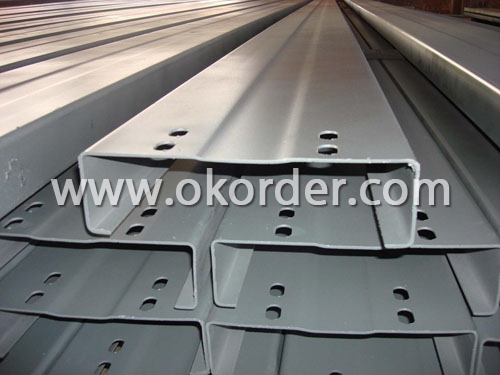
Production Flow of Cold-Rolled C Channel Bar:
1.The steel billet shall be heated in the high temperature furnace.
2. The heated steel billet shall be rolled five to nine times with the aim of shaping the general figure of steel u channel.
3. The hot rolled channel steel should be put onto the cooling bed to make the temperature low.
4. The channel steel should be straighted on the straightener.
5. The straighted channel steel will be cut into meters by saw, as per customer's requirements.
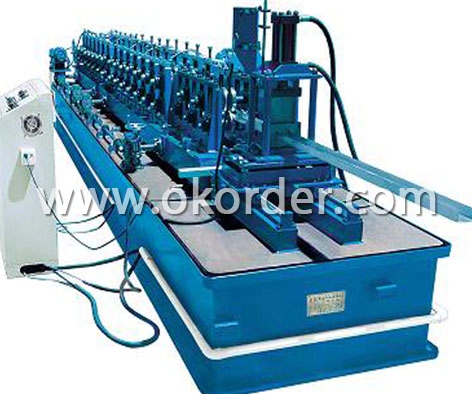
- Q: How do steel channels contribute to sustainable construction practices?
- There are several ways in which steel channels contribute to sustainable construction practices: 1. Long-lasting and durable: Steel channels have a high level of durability and a long lifespan. This means that they do not need to be replaced or repaired frequently, resulting in a reduction in waste generation and material consumption over time. 2. Recyclable: Steel is one of the most recycled materials globally. At the end of their lifespan, steel channels can be easily recycled. This reduces the demand for new steel production and saves energy and resources. 3. Optimal use of materials: Steel channels can be designed to have an ideal strength-to-weight ratio. This allows for the use of less material while maintaining structural integrity. As a result, the overall weight of the construction is reduced, leading to lower transportation and foundation costs. 4. Improved energy efficiency: Steel channels are commonly used in framing systems, which can enhance the energy efficiency of buildings. Steel framing enables better insulation, resulting in reduced energy consumption for heating and cooling. Moreover, steel channels can be combined with other sustainable practices, such as utilizing renewable energy sources or incorporating green building materials. 5. Resilience to natural disasters: Steel channels possess high strength and resistance to fire, earthquakes, and extreme weather conditions. By incorporating steel channels into construction, buildings can be designed to withstand these hazards, reducing damage and enhancing the safety and resilience of the structures. 6. Minimized construction waste: Steel channels can be prefabricated off-site, leading to a reduction in construction waste generation. Prefabrication allows for better quality control, minimizes on-site material waste, and decreases construction noise and disruption. In summary, steel channels promote sustainability in construction through their durability, recyclability, optimal use of materials, energy efficiency, resilience to natural disasters, and reduced construction waste.
- Q: What are steel channels?
- Steel channels are structural components made from steel that are shaped like a "C" or a "U". They are commonly used in construction and engineering projects to provide support and stability. Steel channels are often used as beams or columns to carry heavy loads and distribute weight evenly. They can also be used as brackets or supports for various applications. These channels are durable, strong, and resistant to deformation, making them a popular choice in the construction industry. They are available in various sizes and thicknesses to accommodate different project requirements.
- Q: Do steel channels have any specific safety considerations?
- Indeed, specific safety considerations must be taken into account when dealing with steel channels. These channels are widely utilized in construction and industrial settings to provide structural support, but mishandling them can result in certain safety hazards. One aspect to consider is the weight and dimensions of steel channels. Due to their heaviness and unwieldiness, proper lifting techniques must be employed to prevent strain or harm to workers. Furthermore, caution should be exercised when working in proximity to or underneath steel channels to prevent potential accidents in the event of a fall or collapse. Another safety concern pertains to the sharp edges and corners of steel channels. These sharp surfaces can cause lacerations or punctures if adequate precautions are not taken. To minimize the risk of injury, workers should don appropriate protective gear, including gloves, safety glasses, and steel-toed boots. Additionally, fire safety should not be overlooked when working with steel channels. As steel is an excellent conductor of heat, steel channels can become hot during a fire incident. To minimize the spread of fire through these channels, suitable fire prevention measures and fire-resistant coatings should be implemented. Lastly, ensuring proper installation and maintenance of steel channels is crucial to uphold their structural integrity and safety. Regular inspections should be conducted to identify any signs of corrosion, damage, or fatigue. Promptly addressing any issues can prevent potential structural failures or accidents. In conclusion, although steel channels are known for their durability and widespread use, it is vital to be mindful of the specific safety considerations associated with them. By adhering to proper safety protocols, workers can mitigate risks and maintain a safe working environment.
- Q: How do steel channels compare to other types of steel profiles?
- Steel channels are a specific type of steel profile that offers several advantages when compared to other types of steel profiles. Firstly, steel channels are known for their high strength and durability. The U-shaped design of steel channels allows them to support heavy loads and resist bending or warping, making them ideal for structural applications. This strength also helps them withstand extreme weather conditions and other external forces, ensuring their longevity. Secondly, steel channels have excellent versatility. They can be easily customized and fabricated to meet specific project requirements. This flexibility allows for various applications, including structural support, framing, and reinforcement. Steel channels also come in a range of sizes and thicknesses, making them suitable for projects of different scales. Furthermore, steel channels exhibit high corrosion resistance. They are commonly made from carbon or stainless steel, both of which have natural anti-corrosion properties. This makes steel channels suitable for outdoor and marine environments where exposure to moisture or chemicals is prevalent. Additionally, steel channels are cost-effective. Steel is a widely available and abundant material, making it relatively affordable compared to other construction materials. Moreover, the durability and longevity of steel channels result in reduced maintenance costs over time, making them a cost-efficient choice for many applications. Lastly, steel channels offer ease of installation. Their uniform shape and standardized dimensions make them simple to work with, reducing installation time and labor costs. This ease of installation also makes steel channels a preferred choice for DIY projects or small-scale constructions. In conclusion, steel channels have several advantages over other types of steel profiles. Their strength, versatility, corrosion resistance, cost-effectiveness, and ease of installation make them a popular choice for a variety of construction projects.
- Q: How do steel channels contribute to the overall durability of a structure?
- The overall durability of a structure is enhanced by steel channels in multiple ways. Firstly, they add strength and support to the structure, making it more resistant to different types of loads, such as compression, tension, and bending. This increased strength enables the structure to withstand external forces like strong winds, earthquakes, or heavy loads. Furthermore, steel channels function as load-bearing elements, transferring the weight of the structure and its contents to the foundation. By evenly distributing the load, steel channels prevent excessive stress on any particular area, thereby reducing the risk of structural failure or collapse. Moreover, steel channels exhibit high resistance to corrosion, which is a major concern in many structures, particularly those in humid or coastal areas. The utilization of steel channels prevents rusting and deterioration over time, ensuring the long-lasting structural integrity of the building. Additionally, steel channels offer versatility in terms of design and construction. They can be easily shaped and manipulated to meet the specific requirements of a structure, facilitating efficient and precise construction. This adaptability makes steel channels an excellent choice for a wide range of architectural designs and applications. In conclusion, steel channels enhance the overall durability of a structure by providing increased strength, load-bearing capabilities, corrosion resistance, and versatility. By incorporating steel channels into the construction process, buildings and other structures can withstand various external forces and maintain their structural integrity for an extended period.
- Q: What are the different methods of finishing steel channels?
- There are several methods of finishing steel channels, including painting, galvanizing, powder coating, and applying a protective coating or plating. Each method offers different benefits and is chosen based on the desired appearance, durability, and environmental considerations.
- Q: Can steel channels be used for structural purposes?
- Steel channels are indeed suitable for structural purposes and are extensively used in the construction industry. They find application in a wide range of structural projects, such as buildings, bridges, and other infrastructure projects. Due to their versatility, steel channels are able to provide strong structural support. They possess exceptional strength and durability, enabling them to withstand heavy loads and ensure structural stability. In structural frameworks, they are frequently employed as beams or columns, effectively supporting the structure and evenly distributing its weight. Moreover, steel channels offer ease of fabrication and installation, which grants flexibility in design and construction. In summary, steel channels are an outstanding choice for structural purposes, given their strength, durability, and versatility.
- Q: Can steel channels be recycled?
- Yes, steel channels can be recycled. Steel is a highly recyclable material and can be continuously reused without losing its properties or strength. When steel channels reach the end of their useful life, they can be collected, sorted, and sent to recycling facilities. The recycling process involves melting the steel channels down to remove impurities, and then reshaping the molten steel into new channels or other steel products. This recycling process not only helps conserve natural resources but also reduces the energy consumption and emissions associated with producing new steel. Therefore, recycling steel channels is an environmentally responsible choice that contributes to a more sustainable future.
- Q: Can steel channels be used for both vertical and horizontal applications?
- Yes, steel channels can be used for both vertical and horizontal applications. Steel channels are versatile structural elements that can provide support and reinforcement in various directions, making them suitable for both vertical load-bearing and horizontal bracing purposes.
- Q: Channel 10, 6 meters long, two ends fixed, how much weight can the middle bear?
- Under the maximum bending moment calculation formula: M=1/8GL?? -1/8gL??, (L=600cm, G: the calculation of the maximum uniform load, G: ibid.)
1. Manufacturer Overview
| Location | Tianjin, China |
| Year Established | 2007 |
| Annual Output Value | Above US$ 15 Million |
| Main Markets | Southeast Asia; Africa |
| Company Certifications |
2. Manufacturer Certificates
| a) Certification Name | |
| Range | |
| Reference | |
| Validity Period |
3. Manufacturer Capability
| a) Trade Capacity | |
| Nearest Port | Tianjin |
| Export Percentage | 15%-20% |
| No.of Employees in Trade Department | 11-20 People |
| Language Spoken: | English; Chinese; |
| b) Factory Information | |
| Factory Size: | Above 6,500 square meters |
| No. of Production Lines | 1 |
| Contract Manufacturing | OEM service offered |
| Product Price Range | average |
Send your message to us
Cold-Rolled C Channel Bar
- Loading Port:
- Tianjin Port,China
- Payment Terms:
- TT or LC
- Min Order Qty:
- 50MT m.t.
- Supply Capability:
- 1000 tons per month m.t./month
OKorder Service Pledge
OKorder Financial Service
Similar products
Hot products
Hot Searches
Related keywords
